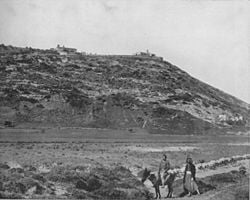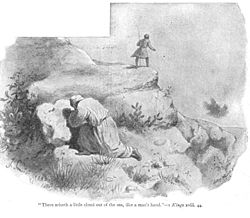Mount Carmel
- For other uses, see Mount Carmel (disambiguation).
Mount Carmel is a coastal mountain range in northern Israel overlooking the Mediterranean Sea. Its name is derived from the Hebrew "Karem El" which means 'vineyards of God'. In ancient times it was covered by vineyards and was at all times famous for its fertility.
A Syrian Philosopher of the 4th century C.E., called Iamblichus, wrote that Mount Carmel was "the most holy of all mountains and forbidden of access to many."
Our Lady of Mount Carmel is a title given to Mary, the mother of Jesus, in honor of her having given the Scapular of Our Lady of Mount Carmel to Saint Simon Stock. Her feast is celebrated on July 16.
Geography
Mount Carmel is 16 miles long by 4-5 miles wide and 1,800 feet high. The city of Haifa is situated at the western promontory of Mount Carmel and partly at its base, along with the smaller towns Nesher and Tirat Hakarmel. Along the ridge are the Druze towns of Daliyat al-Karmel and Isfiya, combined to form Carmel City since 2003. The town of Yokneam is located on the eastern part of Mount Carmel, and the town of Zikhron Ya'aqov on its southern part.
Biblical Carmel
In the Bible, Carmel is first mentioned as the location a Jokneam, a twon conquered by Joshua (Josh. 12:22). It is also mentioned as the western boundary of the tribe of Asher (Josh. 19:24). King Saul reportedly established a victory monument there after his victory over the Amalekites (1 Samuel 15:12). Carmel was also the home of David's wise wife Abigail and her first husband, the wealthy but foolish Nabal (1 Samuel 25).
Carmel's greatest claim to fame, however, was the battle that took place their between the prophet Elijah and the 450 prophets of Baal, together with 400 prophets of Ashera. Here the mountain, located in a kind of no-mans-land between Israel and Phoenecia, represents a strategic high ground where the Phoenician Baal and the Israelite Yahweh contend. Elijah puts the prophets of Baal to shame when he is able to produce fire from heaven to consume his sacrifice to Yahweh, while the prophets of Baal desperately fail to produce fire from Baal to consume their offering. Having proved his point spiritually, Elijah proceeds to order the assembled crowd of onlookers to slaughter the prophets of Baal in the valley below. He then prays to the Lord to end the drought, and a rain cloud appears in response to his plea.
Elijah's protege, the prophet Elisha maintains a dwelling place at Carmel during his own ministry (2 Kings 4:25). The prophet Amos speaks as Carmel as a place of supposed refuge which will not suffice on the day of God's reckoning (Amos 9:3}. It is refered to by the prophets Jeremiah (46:18) and Isaiah ( 35:2) as a symbol of majesty, and the male character in the Song of Solomon tells his beloved "Your head crowns you like Mount Carmel." (Song of Solomon 7:5) Jeremiah also predicts that Israel will one day return from exile, and Carmel will again be known as a rich pastureland from the nation's flocks (50:19).
History
Mount Carmel is mentioned in the Bible. On Mount Carmel transpired the miracles attending the competition between Baal and the Israelite God YHWH, after which the priests of Baal were put to death by the order of the prophet Elijah (see 1Kings 18).
A Catholic religious order, the Carmelites, was founded on Mount Carmel in the 12th century by a certain Berthold (d. after 1185) who was either a pilgrim or crusader. The order grew to be one of the major Catholic religious orders worldwide. Prefixed to the 1281 Carmelite Constitution was this statement: "From the times when the prophet Elias (Elijah) and Eliseus dwelt devoutly on Mount Carmel, holy fathers both of the old and new Testament....lived praiseworthy lives in holy penitence by the fountain of Elias in a holy succession uninterruptedly maintained."
Carmelite tradition suggests that a community of Jewish hermits lived on Mount Carmel from the time of Elijah, although no documentary evidence of such a community exists.
During World War I, Mount Carmel played a significant strategic role. The Battle of Megiddo took place at the head of a pass through the Carmel Ridge, which overlooks the Valley of Jezreel from the south. General Allenby led the British in the battle, which was the turning point in the war against the Ottoman Empire. Megiddo is the site mentioned in the Book of Revelation as the Battle of Armageddon.
The remains of the Báb arrived in the vicinity of Mount Carmel in 1899 and were first laid to rest within the Shrine in 1909. The Shrine of the Báb, completed in the 1950s, is on the side of Mount Carmel in the middle of the Bahá'í-owned terraces. Also located on Mount Carmel are a set of Bahá'í administrative buildings referred to as the Arc. The location was designated by the Faith's founder in the Tablet of Carmel. The mountain remains a sacred place for Bahá'ís around the world.
Modern Essene groups point that Mount Carmel was the spiritual stronghold of the northern Essene movement - the "Nazareans" - described by the Church Father Epiphanius in his Panarion (1:18) and briefly noted by the historian Josephus in his War of the Jews. Excavations on Mount Carmel in 1958 uncovered what is seen as Elijah's altar, the cave where he lived, the fountain of Elijah, and the remains of an ancient monastery.
Archaeology
From 1930 to 1932, at Mount Carmel, Israel, Dorothy Garrod excavated Neanderthal and early modern human remains in the Carmel Caves of el-Wad, el-Tabun, and es- Es Skhul."[1]
"Photographs and diaries document the 1932 discovery at Mount Carmel, Palestine, of the Neanderthal female skeleton, Tabun I, one of the most important human fossils ever found (Christopher Stringer, custodian of Tabun I, Natural History Museum, quoted in the Exhibition in Honour of D.A.E. Garrod, Callander and Smith, 1998). The excavation of Tabun produced the longest stratigraphic record in the region, spanning 600,000 or more years of human activity."[2]
"The long cultural sequence exposed in the four caves and rock-shelters that make up the Nahal Me'arot site, Tabun, Jamal, el-Wad and Skhul, extends from the Lower Palaeolithic to the present day, thus representing nearly a million years of human evolution. In addition to evidence for numerous palaeo-environmental fluctuations, there are also several well-preserved burials of two Middle Paleolithic human types (Neanderthals and Early Anatomically Modern Humans) and passage from nomadic hunter-gatherer groups to complex, sedentary agricultural societies is extensively documented at the site. Taken together, these emphasize the paramount significance of the Mount Carmel caves for the study of human cultural and biological evolution within the framework of palaeo-ecological changes."[3]
Other uses of the name
Mount Carmel is widely recognized as a Sacred mountain directly related, in its origins, to Judaism and Christianity, the ancient Essene Brotherhood, and a place which historically influenced other place names, religious movements - eg. Bahá'í Faith - and literature around the world till today, meaning that it works in practice as a World heritage.
Many other mountains and places around the world have been named Carmel after the biblical mountain. See the disambiguation articles Mount Carmel (disambiguation) and Carmel for a list of them.
External links
- Mount Carmel - BiblePlaces.com, pictures and text illuminating the biblical site of Mount Carmel
- From Mount Carmel to Mount Ecclesia, a Christian mystic view
- Mount Carmel Area Reviews, texts and photos
Credits
New World Encyclopedia writers and editors rewrote and completed the Wikipedia article in accordance with New World Encyclopedia standards. This article abides by terms of the Creative Commons CC-by-sa 3.0 License (CC-by-sa), which may be used and disseminated with proper attribution. Credit is due under the terms of this license that can reference both the New World Encyclopedia contributors and the selfless volunteer contributors of the Wikimedia Foundation. To cite this article click here for a list of acceptable citing formats.The history of earlier contributions by wikipedians is accessible to researchers here:
The history of this article since it was imported to New World Encyclopedia:
Note: Some restrictions may apply to use of individual images which are separately licensed.


